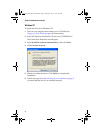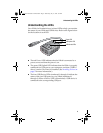
11
About USB
About USB
USB stands for Universal Serial Bus. It is the interface between
your computer and the USB devices you plug into it. Your
computer communicates with USB devices through the USB
interface.
Some USB features are particularly important to desktop computer
users:
■ USB is one-size-fits-all—any USB device can be plugged into
any USB port using the appropriate USB cable.
■ USB devices feature plug-and-play installation—you don't have
to open your computer or add special hardware to install a new
USB device. Once you plug your USB device into your
computer (or hub) and turn it on, you can start using it right
away.
■ You can hot-swap USB devices. You can easily unplug your
digital camera to take away with you, or plug in your joystick
during your lunch break.
■ You can have many USB devices connected to your computer at
once. Most newer computers come with 2 USB ports. USB hubs
can provide additional ports.
USB 1.1 vs USB 2.0
USB 2.0 transfers data at 480 Megabits per second. USB 1.1
transfers data at 12 Megabits per second—that makes USB 2.0 up to
40 times faster than USB 1.1.
USB 1.1 devices cannot operate at USB 2.0 speeds even when
connected to a USB 2.0 hub or adapter.
XHub for Notebooks UG Book.book Page 11 Wednesday, July 17, 2002 3:48 PM


















